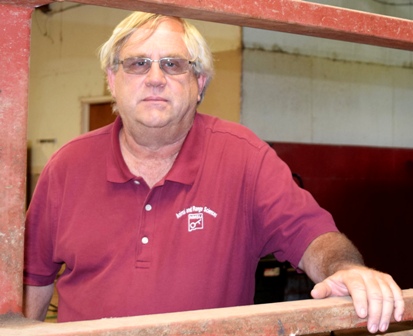 New Mexico State University Professor Glenn Duff returns to the College of Agricultural, Consumer and Environmental Sciences' Clayton Livestock Research Center as superintendent.
New Mexico State University Professor Glenn Duff returns to the College of Agricultural, Consumer and Environmental Sciences' Clayton Livestock Research Center as superintendent.
(NMSU photo by Jane Moorman)WRITER: Jane Moorman, 505-249-0527, jmoorman@nmsu.edu
CLAYTON – On the windblown plains of northeastern New Mexico stands a feed mill and livestock pens with the sole purpose of researching how cattle react to the feedlot environment.
Research at New Mexico State University's College of Agricultural, Consumer and Environmental Sciences' Clayton Livestock Research Center is the culmination of cattle research.
"This facility's primary focus is protocols for cattle, particularly evaluating the health and performance of newly received cattle, and nutrition and management of the cattle from feedlot to slaughter," said Glenn Duff, NMSU professor of livestock management and superintendent of the center.
"The 48-pen facility with feed mill is one of the outstanding research centers in the country," he said. "A lot of research can be done here. With a capacity of 20 calves per pen, that's enough numbers for solid findings."
Duff returns to Clayton following a stint as department head of NMSU's Animal and Range Sciences Department. Since earning his doctorate at NMSU, he has worked in calf, dairy and feed mill research at the University of Arkansas, University of Arizona and Montana State University, and private industry in Garden City, Kansas.
He returned to NMSU in 1994 and served as superintendent of the Clayton facility prior to leaving in 2001 to work at the University of Arizona until 2010. After serving as Department Head for Animal and Range Sciences and as interim dean of Montana State University's College of Agriculture, he returned to NMSU in July 2015 as the department head.
"It's a pleasure being back here," he said. "The facility has been in a stand-by mode for a year because of maintenance issues with the feed mill, but we are working to get it back up and running. We expect to have cattle in the pens in the fall."
The studies conducted at Clayton are the culmination of research by the Animal and Range Sciences Department on campus in Las Cruces and off campus at the Corona Range and Livestock Research Center.
"Unfortunately, there is a perception in the feedlot industry that New Mexico calves are sickly. It's not necessarily true," he said. "So previous research conducted at Clayton concentrated on health and performance on newly received calves from New Mexico."
Healthy calves is the desire of all livestock producers. Reaching that goal begins with maternal nutrition, grazing and feed efficiency, and calf nutrition after weaning.
"We are trying to make our research fit what is needed. To make sure what we are doing has a practical application," said Shanna Ivey, NMSU Animal and Range Sciences interim department head. "We are trying to help the producer to have the best use of their natural resources by providing research-based information for them to make decisions based on the needs of the cattle and to be profitable."
The research begins in labs at NMSU where ruminant microbiologists study how cattle digestive systems process feed and forage.
"The nutrition consumed by the mother impacts her ability to breed and the composition of her milk," said Ivey. "At Corona we are focusing on nutrition supplement efficiency and fertility."
With the diverse rangeland, from short-grass prairie ecosystem to the semi-arid environment of southwestern New Mexico, the Corona ranch and NMSU's Chihuahuan Desert Rangeland Research Center focus on sustainability and management of natural resources and environmental ecosystems.
"Forage fuels cattle growth and development," said Duff. "Our research centers focus on helping ranchers raise quality cattle for market."